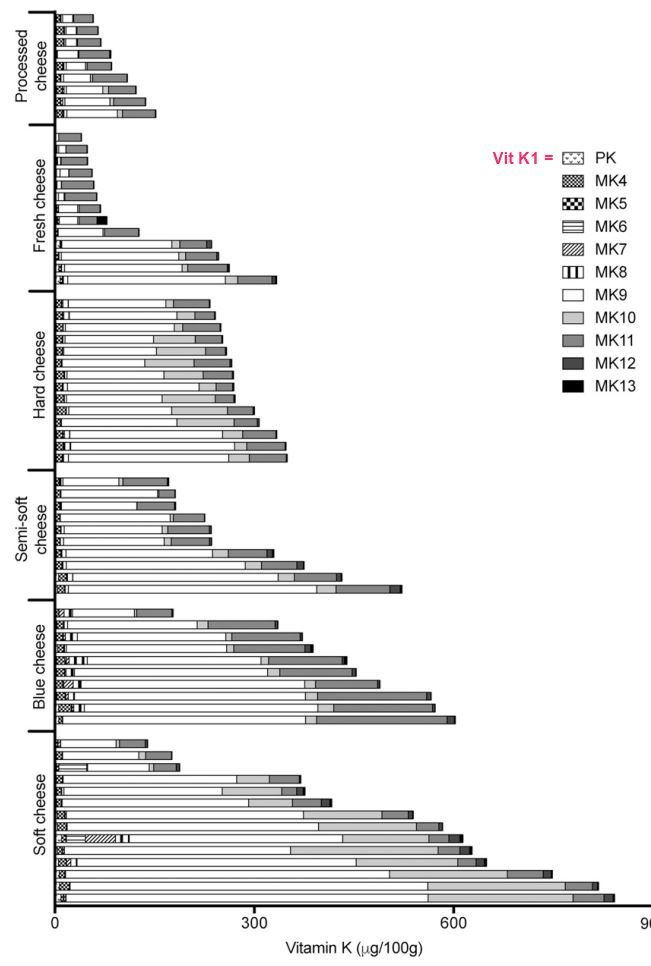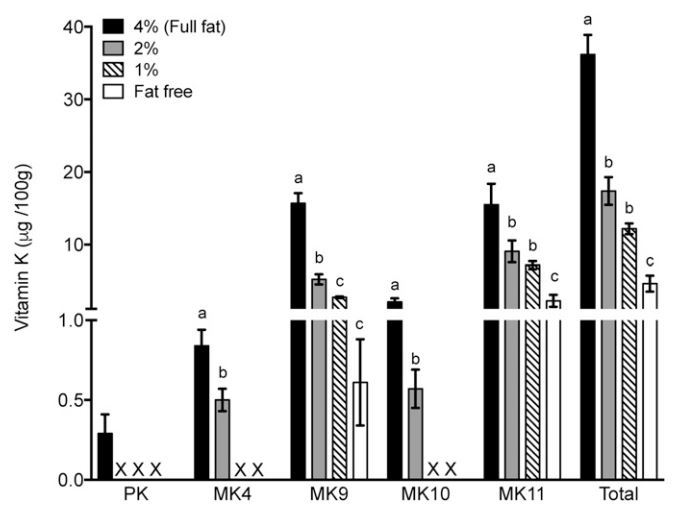Vitamin K2 - MK4, MK9, MK11, MK12 in full-fat diary products
Multiple Vitamin K Forms Exist in Dairy Foods.
Curr Dev Nutr. 2017 Jun 1;1(6):e000638. doi: 10.3945/cdn.117.000638. eCollection 2017 Jun.
Fu X1, Harshman SG1, Shen X1, Haytowitz DB2, Karl JP3, Wolfe BE4, Booth SL1.
1 Jean Mayer USDA Human Nutrition Research Center on Aging at Tufts University, Boston, MA.
2 Beltsville Human Nutrition Research Center, USDA-Agricultural Research Service, Beltsville, MD.
3 Military Nutrition Division, US Army Research Institute of Environmental Medicine, Natick, MA.
4 Department of Biology, Tufts University, Medford, MA.
📄 Download the PDF from VitaminDWiki

Milk

Dairy

Background: The plant-based form of vitamin K (phylloquinone, vitamin K-1) has been well quantified in the US diet. Menaquinones (vitamin K-2) are another class of vitamin K compounds that differ from phylloquinone in the length and saturation of their side chain, but they have not been well characterized in foods.
Objectives: The objectives of this study were to 1) quantify phylloquinone and the different forms of menaquinones [menaquinone (MK) 4-MK13] in milk, yogurt, Greek yogurt, creams, and cheeses and 2) compare the menaquinone contents of full-fat, reduced-fat, and nonfat dairy products.
Methods: All dairy samples were either obtained from the USDA National Food and Nutrient Analysis Program or purchased from retail outlets. Phylloquinone and menaquinone concentrations in these dairy products were quantified by mass spectrometry technology.
Results: Full-fat dairy products contained appreciable amounts of menaquinones, primarily in the forms of MK9, MK10, and MK11. We also measured modest amounts of phylloquinone, MK4, MK8, and MK12 in these products. In contrast, there was little MK5-7 or MK13 detected in the majority of dairy products. The total vitamin K contents of soft cheese, blue cheese, semi-soft cheese, and hard cheese were (means ± SEMs): 506 ± 63, 440 ± 41, 289 ± 38, and 282 ± 5.0 µg/100 g, respectively. Nonfermented cheeses, such as processed cheese, contained lower amounts of vitamin K (98 ± 11 µg/100 g). Reduced-fat or fat-free dairy products contained ∼5-22% of the vitamin K found in full-fat equivalents. For example, total vitamin K contents of full-fat milk (4% fat), 2%-fat milk, 1%-fat milk, and nonfat milk were 38.1 ± 8.6, 19.4 ± 7.7, 12.9 ± 2.0, and 7.7 ± 2.9 µg/100 g, respectively.
Conclusions: To the best of our knowledge, this is the first report of menaquinone contents of US dairy products. Findings indicate that the amount of vitamin K contents in dairy products is high and proportional to the fat content of the product.
